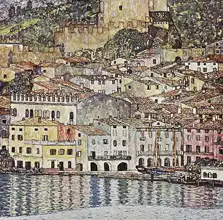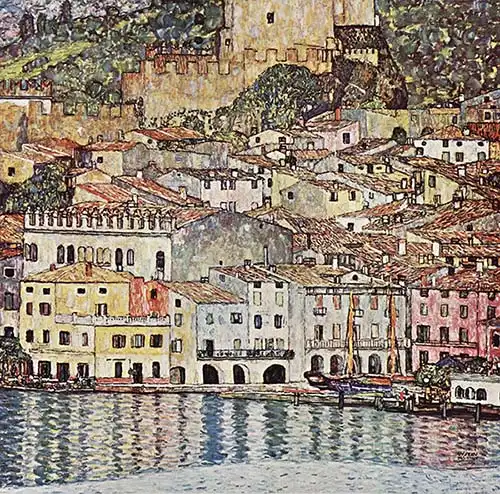About this finishing
Print. The image is printed on the top quality 10-ink HP Z9PS printer on HP matte 270 g / m2 paper. You can choose any size to an accuracy of 1 cm. A margin of 5 cm around the image is added to the size of the motif.


You can find a detailed description about our finishings
here.
Malcesine
Date:
1913Medium:
five-color lithographic lithography with brush, crayon and spray techniqueLocation:
MAK (Austrian Museum of Applied Arts) Vienna, AustriaMalcesine, a picturesque town in Verona, where
Gustav Klimt rested by Lake Garda in 1913. It was here that Klimt painted a picture bearing the same name as this picturesque place in Italy. The entire painting is covered in bright colors that are reflected in the surface of the lake. It's a wonderfully light, expansive work in contrast to the usual claustrophobic style of his typically intense Austrian scenes.
Klimt painted picture Malcesine in 1913. Prevailing color of this fine art print is brown and its shape is square. This art piece is located in MAK (Austrian Museum of Applied Arts) Vienna, Austria. This image is printed on demand - you can choose material, size and finishing.
Gustav Klimt (1862-1918). As a painter, Klimt represents the best period of Vienna – a time when the works of Sigmund Freud or Mahler were developing, and Vienna was at the very least the Central European centre of culture and education. Klimt’s work combines
symbolism and Byzantine features that create the undertone of his Art Nouveau style. Klimt’s images have a special, even anxious, atmosphere that often shows the Freudian idea of erotica in any human movement and action. Klimt paints two-dimensionally, with intense colour while at the same time very gently and with refined dignity. Among Klimt’s famous works are the
Water Snakes - two women with stylized, interwoven bodies that evoke the surreal world of fantasy and sensuality. Another masterpiece is
Danae, a work inspired by Greek mythology, depicting a girl seized by Zeus, who was turned into a golden rain (Danae later gave birth to Perseus). His paintings often aroused passions and public protests, not only for their content but also for the innovative painting methods - eg.
The Girlfriends, an image of two women at a romantic meeting.


